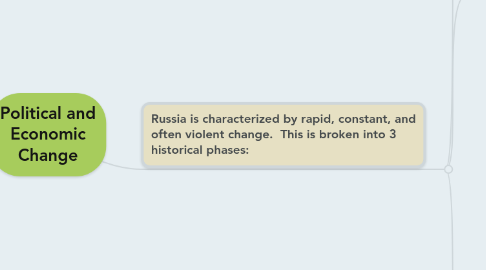
1. Russia is characterized by rapid, constant, and often violent change. This is broken into 3 historical phases:
1.1. Tsarist Rule
1.1.1. First were princes who were forced to work with the Mongols, until they declared themselves "Tsars" after Mongol power declined.
1.1.2. Also headed the Orthodox Church, so they were viewed as both political and religious leaders.
1.1.3. Western Influence
1.1.3.1. Peter the Great
1.1.3.1.1. St. Petersburg = "Window to the West"
1.1.3.2. Catherine the Great
1.1.3.2.1. Expanded empire to the Black Sea
1.1.3.2.2. Seen as an "enlightened despot"
1.1.3.3. 19th Century Tsars
1.1.3.3.1. Faced revolts and military losses (Crimean War), which led to unrest by citizens.
1.1.3.3.2. Tsars reacted with harsh military and secret police measures to crush dissidents.
1.2. 20th Century Communist Rule
1.2.1. Lenin and the Bolsheviks
1.2.1.1. Vladimir Lenin changed the meaning of Marxism when he argued for democratic centralism
1.2.1.1.1. Democratic centralism is a leadership group that would lead the revolution because the people could not organize themselves
1.2.1.1.2. This has also been referred to as Marxism-Leninism.
1.2.1.2. Lenin and the Bolsheviks led the red Army against the white army that was backed by the Allied powers
1.2.1.3. In 1920 he instituted the new economic policy, which allowed a great deal of private ownership to exist under a centralized leadership
1.2.2. Stalinism
1.2.2.1. New emphasis on the Communist Party as the sole political entity
1.2.2.1.1. Stalin placed the party at the center and carefully selected members.
1.2.2.1.2. Leaders were identified through Nomenklatura or the process of party members selecting party members from lower-levels
1.2.2.1.3. Most officials belonged to the Central committee, a group of 300 party leaders that met twice a year.
1.2.2.1.4. The heart and soul of the Communist Party was the politburo, which was above the Central committee.
1.2.2.2. Collectivization
1.2.2.2.1. The new economic policy was replaced with collective farms that were state run.
1.2.2.2.2. Private landownership was abolished
1.2.2.2.3. Food from the farms was intended to feed workers of the cities that contributed to the industrialization of the country
1.2.2.2.4. There was some resistance in the peasant class of kulaks, that were forced to move to cities or labor camps and died in untold numbers.
1.2.2.3. Industrialization
1.2.2.3.1. This was carried out by Gosplan, the Central State planning commission
1.2.2.3.2. Implemented in what became known as five-year plans
1.2.2.4. Stalin's foreign-policy
1.2.2.4.1. Stalin's policy became known as "socialism in one country" to emphasize his split with traditional Marxism
1.2.2.4.2. Before during and after World War II, all of Stalin's strategies accommodated his main goal, which was the industrial development of the USSR
1.2.2.5. Stalin's purges
1.2.2.5.1. Stalin executed millions of people including up to 1 million of his own party membership
1.2.3. Reform under Khrushchev and Gorbachev
1.2.3.1. After taking power in 1953 Khrushchev gave a secret speech in which he revealed the existence of a letter written by Lenin before he died
1.2.3.1.1. This led to a process known as de- Stalinization which loosened government censorship of the press, decentralized some economic decision-making, and restructured collective farms.
1.2.3.1.2. Khrushchev was criticized for the reforms and eventually was ousted after the Cuban missile crisis ended.
1.2.3.2. Mikell Gorbachev took power in 1985 and was much more open to Western-style reforms than previous general secretaries
1.2.3.2.1. He had a three prong approach
1.3. Regime Change in 1991 to Present
1.3.1. In August, 1991 anti-Gorbachev conservatives from within the Politburo led an overthrow, attempting to remove Gorbachev from office
1.3.2. After the revolution ended Yeltsin began to create a Western-style democracy
1.3.2.1. The constitution of 1993 created a three branch government with a president, Prime Minister, a bicameral legislature, and a constitutional court
1.3.2.2. Yeltsin installed "shock therapy" into the economy
1.3.2.3. Yeltsin's leadership proved to be ineffective and after resigning before the election of 2000, Vladimir Putin became acting Pres.
1.3.3. The coup d'état failed after protests broke out, led by Boris Yeltsin, the elected Pres.
1.3.3.1. Many members of the military defected to Yeltsin's side
1.3.3.2. Gorbachev was restored power but by December 11 former republics had already declared independence and Gorbachev had to announce the end of the Soviet Union
